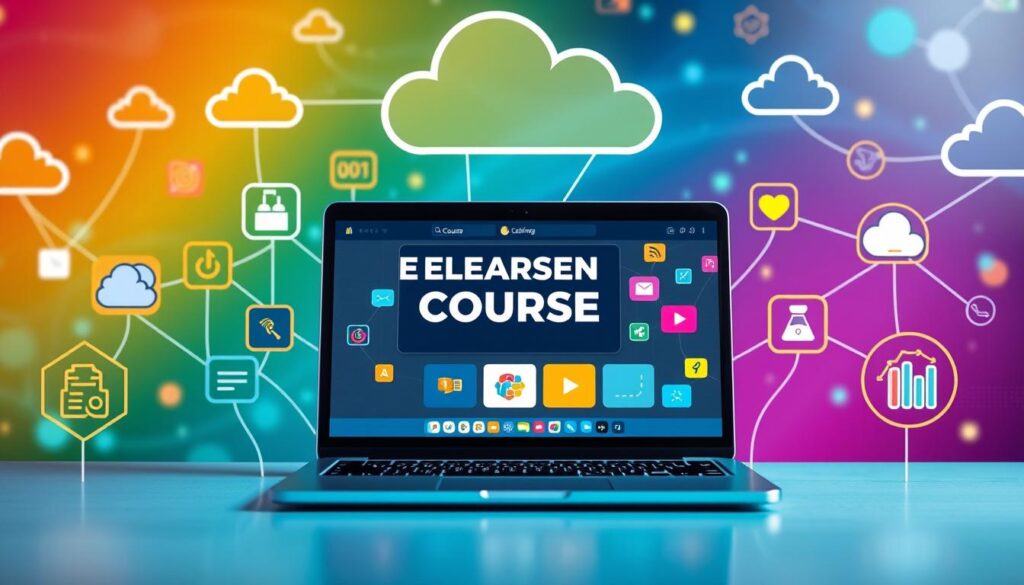E-learning platforms have changed the game in education and professional growth. They let people learn new skills and grow their knowledge from home or anywhere. These platforms are great for students, workers, and entrepreneurs who want to keep learning.
This article will guide you through the world of e-learning. We’ll look at the best features, benefits, and types of online learning. You’ll see top platforms for work and school, and even affordable options for small businesses. We’ll also talk about new trends and how to keep your learning safe and private.

Key Takeaways
- Discover the best e-learning platforms online that enable learning from anywhere
- Understand the key features and benefits of modern virtual learning environments
- Explore the top e-learning platforms for professional development and academic institutions
- Learn about cost-effective digital learning solutions for small businesses
- Stay informed about the latest trends and essential features in web-based learning platforms
Understanding E-Learning Platforms: A Complete Guide
In today’s world, learning management systems, e-learning software, and educational technology platforms have changed how we learn. These tools are key for students, teachers, and companies in many fields. Let’s explore the main features, benefits, and types of online learning environments that are changing education.
Key Features of Modern Learning Platforms
Modern learning systems and e-learning software have many features that make learning better. They include tools for making interactive content, video chats, automatic grading, and detailed student data analysis. These tools help students get involved in their learning and give teachers insights to improve their teaching.
Benefits of Online Learning Solutions
- Online learning is more accessible and flexible, letting students learn at their own pace and from anywhere.
- It’s also more affordable, needing less physical space and resources.
- It offers personalized learning, adapting to each student’s needs and learning style.
- It also makes it easier to work together and network through virtual classrooms and forums.
Types of Virtual Learning Environments
The world of educational technology has many solutions, each for different needs. Here are some common types of virtual learning environments:
- Learning Management Systems (LMS): These are full platforms for creating, delivering, and managing courses.
- Massive Open Online Courses (MOOCs): These are online courses that many people can take, offering access to educational resources.
- Blended Learning Platforms: These mix online and offline learning, offering a balanced approach.
- Virtual Simulation Environments: These are advanced platforms for hands-on skill development through technology.
As the need for new learning solutions grows, the educational technology field keeps changing. It offers many chances for learners, teachers, and companies to use digital tools to improve education.
“The future of education is digital, and e-learning platforms are leading the charge in redefining the way we learn, teach, and grow.”
Top E-Learning Platforms Online for Professional Development
In the fast-changing world of online learning, many digital learning solutions stand out for professional growth. These online training platforms have a wide range of courses and resources. They are designed for working professionals who want to improve their skills and move up in their careers.
Leading remote learning tools include Coursera, Udemy, and LinkedIn Learning. Each platform has special features and benefits for professionals in different fields.
Coursera: Partnering with Top Universities
Coursera is known for working with top universities and organizations. It offers a wide range of courses, specializations, and degree programs. With its detailed curriculum and relevant content, Coursera helps professionals gain important skills and earn recognized credentials.
Udemy: Diverse and Accessible Learning
Udemy is a well-liked digital learning solution with a huge library of courses. Its easy-to-use interface and low prices make it a great choice for those looking for flexible and affordable online training.
LinkedIn Learning: Personalized Professional Growth
LinkedIn Learning, formerly Lynda.com, uses LinkedIn’s network to offer personalized learning. It’s great for professionals who want to match their learning with their career goals.
These online training platforms have different features, prices, and learning experiences. This lets professionals pick the digital learning solutions that best meet their needs and preferences.
| Platform | Key Features | Pricing |
|---|---|---|
| Coursera | Accredited courses from top universities Specializations and degree programs Hands-on projects and assessments | Free courses available Paid courses and programs ranging from $39 to $79 per month |
| Udemy | Vast library of on-demand courses Affordable pricing Flexible learning options | Individual courses priced from $9.99 to $199.99 Subscription plans available |
| LinkedIn Learning | Personalized course recommendations Integrated with LinkedIn profile and network Skill assessments and certificates | $29.99 per month or $299.88 per year Free trial available |
These top e-learning platforms offer many learning chances for professionals. They help improve skills and reach career goals through digital learning solutions.
Popular Learning Management Systems for Educational Institutions
In the world of education, learning management systems (LMS) are key. They help schools and universities improve learning and make things easier for teachers. These online platforms have many features to help students learn better and make teaching easier.
Enterprise LMS Solutions
Bigger schools often use top-level LMS solutions. These systems manage courses, share content, keep students engaged, and analyze data. Big names like Canvas, Blackboard, and Moodle offer special features and customization to fit different schools’ needs.
Academic Platform Integration Options
Today’s LMS systems also work well with other school tools and software. This helps schools use what they already have and make a complete digital system. They can connect with video tools, content creators, and student info systems, making learning smoother and more efficient.
Student Management Features
Good LMS systems help manage students well. They handle things like signing up, tracking attendance, managing grades, and checking progress. This helps schools support students better and find ways to help them grow.
| LMS Solution | Key Features | Pricing Model |
|---|---|---|
| Canvas | Intuitive course management Collaborative learning tools Advanced analytics and reporting | Subscription-based, with pricing based on institution size |
| Blackboard | Comprehensive e-learning features Integrations with third-party tools Robust mobile learning capabilities | Subscription-based, with enterprise-level pricing |
| Moodle | Open-source and highly customizable Extensive add-ons and plugins Strong community support | Free to use, with optional paid support and hosting services |

As schools aim to improve learning, using strong LMS systems is key. These platforms offer many features and ways to connect with other tools. They help make teaching easier, keep students involved, and help students succeed.
Cost-Effective Digital Learning Solutions for Small Businesses
Small businesses face a big challenge in the digital world. They need affordable online training platforms. Luckily, there are many digital learning solutions and e-learning software options for them.
Teachable is a great choice for small businesses. It has an easy-to-use interface and tools to create and sell courses. Starting at $0 per month, Teachable grows with your business.
| Platform | Pricing | Features |
|---|---|---|
| Teachable | Free plan available, paid plans start at $29/month | Customizable course creation, integrated payment processing, student management tools |
| Podia | $39/month for the Mover plan | Digital storefront for selling courses and memberships, email marketing integration, webinar hosting |
| Thinkific | Free plan available, paid plans start at $49/month | Drag-and-drop course builder, mobile-responsive design, advanced quizzing and certification options |
Podia is another affordable choice. It has a digital storefront for selling courses and memberships. It also offers email marketing and webinar hosting. Plans start at $39 per month.
Thinkific is great for small businesses looking for more. It has a drag-and-drop course builder and mobile-responsive design. It also has advanced quizzing and certification features. Pricing starts at $49 per month.
By looking into these digital learning solutions, small businesses can improve their employees’ skills. They can do this without breaking the bank. This helps them stay ahead in the fast-changing business world.

Essential Features of Web-Based Learning Platforms
Online education is becoming more popular, and web-based learning platforms are key. They offer many features that improve learning and meet the needs of students and teachers.
Interactive Learning Tools
Good web-based learning platforms have interactive tools that keep learners engaged. They include videos, animations, and simulations. They also have features for real-time collaboration, like discussion forums and virtual whiteboards.
These tools make learning more fun and help learners remember what they’ve learned.
Assessment and Progress Tracking
Top web-based learning platforms have great tools for checking how well learners are doing. They let teachers give feedback and track how each student is doing. Learners can see how they’re doing and take charge of their learning.
Mobile Learning Capabilities
Today, learners are always on the move. They need to be able to learn on their phones or tablets. The best platforms let learners access materials and take part in discussions anytime, anywhere.
These features make learning more flexible and convenient for today’s learners.

Comparing Free vs Paid Online Training Platforms
The debate between free and paid online training platforms is ongoing. It attracts both learners and educators. Understanding the pros and cons of each is key to making a good choice.
Exploring the Advantages of Free Online Training Platforms
Free digital learning solutions are appealing because they’re accessible. They offer many courses and resources for free. This makes learning more open to everyone, especially those with tight budgets.
Unveiling the Benefits of Paid Online Training Platforms
Paid platforms offer a more detailed and personalized learning experience. They have advanced features like:
- Personalized learning paths
- In-depth course materials and assessments
- Dedicated support and feedback from instructors
- Accredited certifications and industry-recognized credentials
This investment leads to a more structured and immersive learning experience. It meets the specific needs and goals of learners.
| Feature | Free Online Training Platforms | Paid Online Training Platforms |
|---|---|---|
| Course Variety | Extensive range of courses, but may lack depth or specialization | Curated selection of high-quality, in-depth courses |
| Instructor Support | Limited to no direct interaction with instructors | Personalized feedback and support from subject matter experts |
| Certification | May offer certificates of completion, but limited recognition | Opportunity to earn industry-recognized credentials and certifications |
| Customization | One-size-fits-all approach, limited personalization | Tailored learning paths and personalized learning experiences |
The choice between free and paid platforms depends on your needs, budget, and goals. Weighing the pros and cons helps make a decision that fits your educational and professional goals.
Remote Learning Tools for Global Education
The world is getting more connected, making online learning more important than ever. Web-based learning platforms and virtual learning environments are key. They help students and professionals from all over the world learn together.
Cross-Cultural Learning Features
Good remote learning tools for global use need to help people understand and connect across cultures. They should have:
- Customizable interfaces that fit different cultural tastes and designs
- Tools for teamwork and communication among learners from different places
- Options to make content available in many languages
Language Support and Localization
For a global audience, remote learning platforms must support many languages and cultures. This lets students learn in their own language, making education more welcoming and accessible.
Time Zone Management Tools
Managing learning across different time zones is a big challenge in online education. Good platforms should have tools like:
- Tools that schedule meetings based on where learners are
- Options for learning at any time, not just at set times
- Easy integration with calendars to plan global learning
With these tools, schools and organizations can offer quality learning to people worldwide. This helps break down barriers and encourages learning and growth together across cultures.

Emerging Trends in Educational Technology Platforms
The world of educational technology is always changing. New digital learning solutions are coming out to change how we learn. These solutions make learning flexible, personalized, and fun.
Artificial intelligence (AI) and machine learning are big in educational technology platforms now. They make learning fit each student’s needs. AI looks at what each student does and gives them content that’s just right for them.
Virtual reality (VR) and augmented reality (AR) are also big. They make learning more real and fun. Students can explore and learn in new ways.
Gamification is another trend. It adds game-like features to learning. This makes learning more fun and helps students remember what they learn.
The future of learning looks bright. It will be more accessible, personalized, and fun. These new ways will help everyone learn better.
Security and Privacy Features in E-Learning Software
Online learning platforms are becoming more popular. It’s crucial to keep user data safe and secure. E-learning software providers work hard to protect sensitive information and keep their learning environments safe. Let’s explore the key security and privacy features in top e-learning software, online course platforms, and web-based learning platforms.
Data Protection Measures
Strong data protection is essential for a secure e-learning system. Top e-learning software uses advanced encryption to keep user data safe. This includes login details, personal info, and academic records. They also have strict access controls to manage user permissions and prevent unauthorized access.
Compliance Standards
Leading online course platforms and web-based learning platforms follow strict privacy rules. They meet standards like FERPA and GDPR. This ensures that data handling practices are top-notch, giving students and schools peace of mind.
User Authentication Methods
Secure login is key in e-learning. Modern e-learning software uses multi-factor authentication and biometric identification. These methods verify user identities and prevent unauthorized access. They make the learning platform more secure, protecting sensitive information and ensuring a trusted learning environment.
The best e-learning software, online course platforms, and web-based learning platforms focus on security and privacy. They create a safe space for students, teachers, and organizations to learn online with confidence.
“In the digital age, security and privacy are non-negotiable for e-learning platforms. Providers who invest in robust protective measures will earn the trust of their users and thrive in the competitive online learning landscape.”
Conclusion
The world of e-learning platforms is full of chances for growth. It offers virtual learning spaces and affordable digital solutions. This has changed online education, making it easier to learn new things at home.
If you want to grow in your career or need top-notch educational tools, there are many e-learning platforms. They meet different needs. Knowing what each platform offers helps you choose the right one for you.
Starting your e-learning path opens up many doors. Sites like Udemy, Coursera, and edX have changed education and career growth. They make learning flexible and accessible, helping you achieve your goals.
FAQ
What are the key features of modern learning platforms?
Modern learning platforms have many features. They include interactive tools and ways to track progress. They also offer mobile learning, collaboration tools, and personalized learning. Plus, they provide insights from data.
What are the benefits of using online learning solutions?
Online learning solutions are flexible and cost-effective. They offer a wide range of courses and personalized learning. You can learn at your own pace. They also help with professional growth and upskilling.
What are the different types of virtual learning environments?
There are many types of virtual learning environments. These include learning management systems (LMS), massive open online courses (MOOCs), and personal learning environments (PLEs). There are also virtual classrooms. Each type meets different educational needs.
What are the top e-learning platforms for professional development?
Top e-learning platforms for professional development include Coursera, Udemy, and LinkedIn Learning. Pluralsight and Skillsoft are also popular. These platforms offer a wide range of courses and certifications in various fields.
What are the essential features of web-based learning platforms?
Web-based learning platforms have key features. They include interactive tools and ways to track progress. They also offer mobile learning, virtual classrooms, and collaboration tools. Plus, they provide data-driven insights to improve learning.
What are the differences between free and paid online training platforms?
Free platforms offer limited courses and basic features. Paid platforms have more courses, advanced features, and support. The choice depends on your needs and budget.
What remote learning tools are available for global education?
For global education, there are tools for cross-cultural learning and language support. They also manage time zones and integrate with virtual classrooms. These tools make online learning inclusive and accessible worldwide.
What are the emerging trends in educational technology platforms?
New trends include AI-powered personalization and virtual reality. Gamification and data analytics are also emerging. These innovations make learning more engaging and personalized.
What security and privacy features are available in e-learning software?
E-learning software has strong security and privacy features. It includes data protection and compliance with standards. It also has user authentication and secure data storage. These features ensure the safety of sensitive information online.
